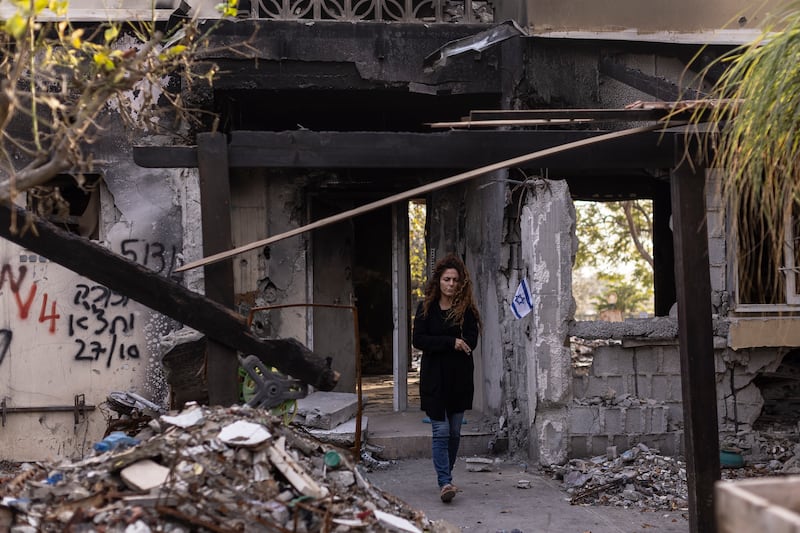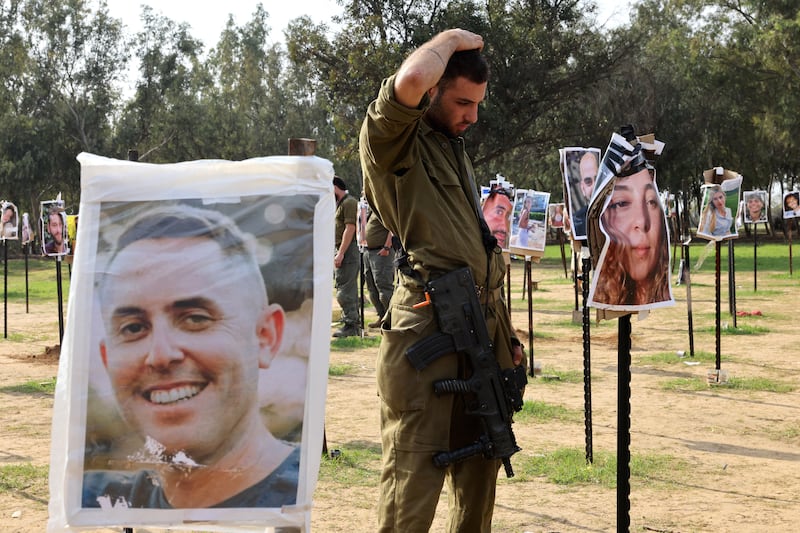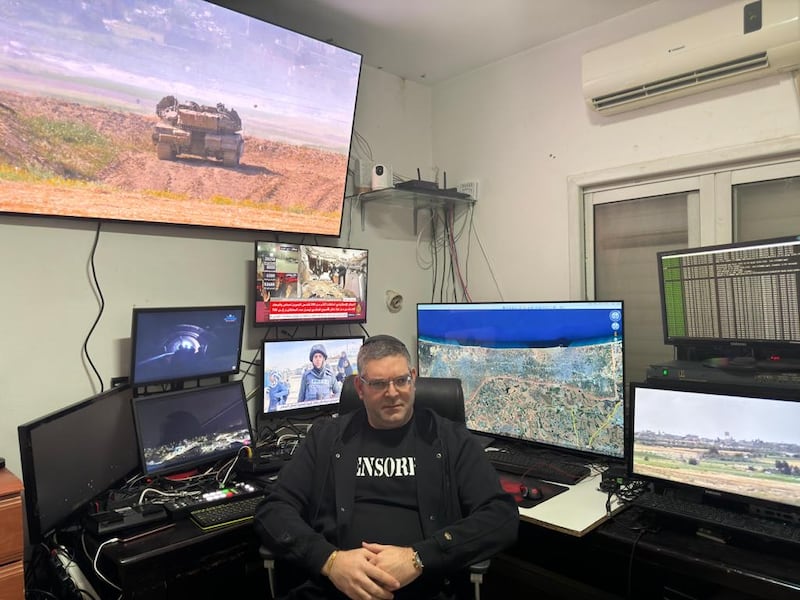Far beneath the Israeli military headquarters in Tel Aviv, in a bunker known as the Pit, commanders were trying to make sense of reports of Hamas rocket fire in southern Israel early on October 7th, when the call came in.
It was a commander from the division that oversees military operations along the border with the Gaza Strip. Their base was under attack. The commander could not describe the scope of the attack or provide more details, according to a military official with knowledge of the call. But he asked that all available reinforcements be sent.
At 7.43am, more than an hour after the rocket assault began and thousands of Hamas fighters stormed into Israel, the Pit issued its first deployment instructions of the day. It ordered all emergency forces to head south, along with all available units that could do so quickly.
But the nation’s military leaders did not yet recognise that an invasion of Israel was already well under way.
RM Block
Hours later, desperate Israeli citizens were still fending for themselves and calling for help. Roughly 1,200 people died as the Middle East’s most advanced military failed in its essential mission: protecting Israeli lives.
The full reasons behind the military’s slow response may take months to understand. The Israeli government has promised an inquiry. But a New York Times investigation found that Israel’s military was undermanned, out of position and so poorly organised that soldiers communicated in impromptu WhatsApp groups and relied on social media posts for targeting information. Commandos rushed into battle armed only for brief combat. Helicopter pilots were ordered to look to news reports and Telegram channels to choose targets.
[ Characterising criticism of Israel as anti-Semitism shuts down debateOpens in new window ]
And perhaps most damning: The Israeli military did not even have a plan to respond to a large-scale Hamas attack on Israeli soil, according to current and former soldiers and officers. If such a plan existed on a shelf somewhere, the soldiers said, no one had trained on it and nobody followed it. The soldiers that day made it up as they went along.
“In practice, there wasn’t the right defensive preparation, no practice, and no equipping and building strength for such an operation,” said Yom Tov Samia, a major general in the Israeli reserves and former head of the military’s southern command.
“There was no defence plan for a surprise attack such as the kind we have seen on October 7th,” said Amir Avivi, a brigadier general in the reserves and a former deputy commander of the Gaza division, which is responsible for protecting the region.
That lack of preparation is at odds with a founding principle of Israeli military doctrine. From the days of David Ben-Gurion, Israel’s first prime minister and defence minister, the goal was to always be on the offensive – to anticipate attacks and fight battles in enemy territory.
In response to a series of questions from the New York Times, including why soldiers and officers alike said there had been no plan, the Israeli military replied, using the abbreviation for the Israel Defense Forces: “The IDF is currently focused on eliminating the threat from the terrorist organisation Hamas. Questions of this kind will be looked into at a later stage.”
The New York Times investigation is based on internal Israeli government documents and a review of the military’s cache of materials, known as Pandora, that contains tens of thousands of videos, including footage from body cameras worn by terrorists and closed-circuit surveillance cameras. The newspaper interviewed dozens of officers, enlisted troops and eyewitnesses, some of whom spoke on condition of anonymity because they were not authorised to speak publicly about military operations.

The documents and interviews revealed new details about the attack, including military assessments and orders such as the one given by the Pit early that morning. Taken together, they show that much of the military failure was due to the lack of a plan, coupled with a series of intelligence missteps in the months and years before the attack.
Israeli security and military agencies produced repeated assessments that Hamas was neither interested in nor capable of launching a massive invasion. Authorities clung to that optimistic view even when Israel obtained Hamas battle plans that revealed an invasion was precisely what Hamas was planning.
The decisions, in retrospect, are tinged with hubris. The notion that Hamas could execute an ambitious attack was seen as so unlikely that Israeli intelligence officials even reduced eavesdropping on Hamas radio traffic, concluding that it was a waste of time.
None of the officers interviewed, including those stationed along the border, could recall discussions or training based on a plan to repel such an assault.
“As far as I recall, there was no such plan,” said Yaakov Amidror, a retired Israeli general and a former national security adviser to prime minister Binyamin Netanyahu. “The army does not prepare itself for things it thinks are impossible.”
(The Israeli government had determined that the loosely organised civilian guard, known as Kitat Konnenut, would serve as the first line of defence in the towns and villages near the border. But the guardsmen had different standards of training depending on who was in charge. For years, they warned that some of their units were poorly trained and underequipped, according to two Israeli military officials with direct knowledge of the volunteer teams.
Additionally, the Israeli military reservists were not prepared to quickly mobilise and deploy. Some described heading south on their own initiative.
Davidi Ben Zion (38), a major in the reserves, said reservists never trained to respond at a moment’s notice to an invasion. The training assumed that Israeli intelligence would learn of a looming invasion in advance, giving reservists time to prepare to deploy.
“The procedure states that we have the battalion ready for combat in 24 hours,” he said. “There’s a checklist to authorise the distribution of everything. We practised this for many years.”
Hamas capitalised on these errors in ways that further delayed the Israeli response. Terrorists blocked key highway intersections, leaving soldiers bogged down in firefights as they tried to enter besieged towns. And the Hamas siege on the military base in southern Israel crippled the regional command post, paralysing the military response.
Much remains unknown about that day, including what orders were given inside Israel’s senior military leadership in Tel Aviv, and when. The New York Times investigation builds on and adds new details to aggressive coverage in the Israeli media of the military response.

Officers and reservists who headed south that morning, whether under orders or on their own, soon learned of the chaos that they were entering.
Gen Barak Hiram, who was scheduled to soon take over command of a division along the Gaza border, drove south to see first hand how the soldiers there responded to what seemed like a routine Hamas attack.
In an interview, he recalled the text messages he received from soldiers he knew in the region.
“Come save us.”
“Send the army, quickly, they are killing us.”
“Sorry we’re turning to you, we’re already out of weapons.”
Unprepared for battle
Commando units were among the first to mobilise that morning. Some said they rushed into the fight after receiving messages pleading for help or learning about the infiltrations from social media.
Other units were on standby and received formal activation orders.
The small size of the teams suggested that commanders fundamentally misunderstood the threat. Troops rolled out with pistols and assault rifles, enough to face a band of hostage-taking terrorists, but not to go into full-scale battle.
Previously undisclosed documents show just how drastically the military misread the situation. Records from early in the day show that, even during the attack, the military still assessed that Hamas, at best, would be able to breach Israel’s border fence in just a few places. A separate intelligence document, prepared weeks later, shows that Hamas teams actually breached the fence in more than 30 locations and quickly moved deep into southern Israel.
Hamas fighters poured into Israel with heavy machine guns, rocket-propelled grenade launchers, landmines and more. They were prepared to fight for days. Israeli commandos apparently believed they would be fighting for just hours; one said he set out that morning without his night-vision goggles.
“The terrorists had a distinct tactical advantage in firepower,” said Yair Ansbacher (40), a reservist in a counterterrorism unit who fought on October 7th. He and his colleagues mainly used pistols, assault rifles and sometimes sniper rifles, he said.
The situation was so dire that at 9am, the head of Shin Bet, Israel’s domestic security agency, issued a rare order. He told all combat-trained, weapons-carrying employees to go south. Shin Bet does not normally activate with the military. Ten Shin Bet operatives were killed that day.
Making matters worse, the military has acknowledged that it moved two commando companies – more than 100 soldiers – to the West Bank just two days before the attack, a reflection of Israel’s mistaken belief that a Hamas attack was not an imminent threat.
That left three infantry battalions and one tank battalion along Gaza’s border. But October 7th was the Jewish holiday of Simchat Torah, and the Sabbath. A senior military officer estimated that about half the 1,500 soldiers in the area were away. He said another infantry battalion had been reassigned years earlier after Israel finished building a security wall around Gaza.
Whether Hamas knew that the military was understaffed is unclear, but it had fatal consequences. When the attacks began, many soldiers were fighting for their lives instead of protecting residents nearby. Hamas stormed one base, Nahal Oz, forcing soldiers to abandon it and leave behind dead friends.
And just as the civilian volunteers had warned, the first line of defence inside Israel was quickly overwhelmed. Some units barely had enough weapons for an hours long battle, officials said.
Hamas also worked strategically to weaken Israel’s advantage in firepower. Terrorists targeted Israeli tanks, hitting several of them, said Brig Gen Hisham Ibrahim, commander of the armoured corps. Tanks ran out of ammunition, leaving crews to fight with ground soldiers.
In another instance widely covered in the Israeli media, Hamas fired on an Israeli helicopter, forcing it down near Gaza. The paratroopers escaped injury before the helicopter burst into flames.
All of this should have been a clear sign that Israel was under broad attack, facing a dire situation.
But Hamas made another strategic strike that morning that all but blinded Israel’s military at a crucial moment.
Understaffed on the holiday
The assault on the Re’im military base left soldiers there fighting for their lives rather than co-ordinating a response to the invasion.
Re’im is home to the Gaza Division, which oversees all military operations in the region. It is also home to two brigades – northern and southern – dedicated to protecting about 65km of the border.
Like other bases, Re’im was understaffed because of the holiday. A brigade commander and key staff were away from the base, according to a senior military officer. They were summoned back before dawn, officials said, as Israeli intelligence officials tried to make sense of unusual Hamas activity just over the border in Gaza.
Many soldiers, though, were allowed to keep sleeping. One told the New York Times that some did not know they were under attack until Hamas was in their sleeping quarters. Several were killed in their bunks. Others barricaded themselves in safe rooms.
The scope of the catastrophe, if not the attack itself, was preventable, according to records and interviews.
“After they built the fence, they put the headquarters in the middle of the sector,” said Samia, former head of the southern command. He said the three commanders of the brigades and division never should have been housed together so close to Gaza’s border.
“In the same camp, you all had three of them – in the same location,” he said. “What a mistake. What a mistake.”

Israeli authorities also knew, years in advance, that Hamas planned to take out Re’im as part of its invasion, documents previously obtained by the New York Times showed. They dismissed that plan, like the prospect of overall invasion, as implausible.
Even in May, when intelligence analysts raised alarms about Hamas training exercises, Israeli officials did not increase troop levels in the south.
The assault on Re’im led to a near blackout of communication inside the unit that co-ordinates troop movements across southern Israel, according to one soldier who was based there on October 7th.
The division that was supposed to be directing the battle was trying not to get overrun.
Even at noon, according to another southern command official, officers there did not understand what was happening. They assessed that Hamas had sent about 200 gunmen into Israel. They were off by a factor of 10.
It took the military most of the day to retake control of the Re’im base.
“When your division is under fire, you’re focused on clearing it from terrorists,” said Ibrahim, the commander of the armoured corps, which is based in southern Israel. “It distracts from management of the fighting more broadly.” Ibrahim defended the military’s response, saying there were few modern armies that could have recaptured the region as quickly as Israel did.
But nobody had trained to repel an invasion.
‘Slowing our advance’
Hamas understood how to use Israel’s geography against its military.
Despite the siege of Re’im, reinforcements were not far away. Thousands of soldiers were less than 40 minutes from the towns that were under attack. But as terrified citizens waited in bunkers or hid from gunmen, Israeli soldiers were hung up on the highway, unable to reach them.
A central highway connects military bases in the centre and south of the country to the communities near Gaza. Pockets of Hamas gunmen set up ambushes along the route, videos from Pandora show. Israeli commanders were hesitant to send soldiers into those traps, according to two Israeli military officers who took part in conversations that morning.
“Hamas is all over the roads,” an Israeli soldier reported in a conversation recounted by a participant. “They own the street, not us.”
One of the deadliest junctions was Sha’ar HaNegev, the intersection of two main arteries leading to the besieged towns and communities known as kibbutzim. Hamas seized the junction by killing motorists, setting fire to their cars and blocking roads, according to military officials and videos.
“Every encounter at the intersections resulted in the killing of the terrorists and slowing our advance,” said Ansbacher, the counterterrorism reservist, recounting the team’s frustrating advance.
“As we go along, we understand that we are really delayed. In the kibbutzim, they need us and people are getting killed.”
Fog of war
The elite Maglan commando unit operates out of a base about 25 minutes from Gaza.
Its deputy commander activated the unit at about 6.30am on October 7th, according to an officer familiar with the operations that day. But the team received little guidance from top Israeli generals or the Gaza division headquarters, which, they did not realise, was itself under attack.
Maglan’s commandos specialised in operating behind enemy lines, where Israel always expected the fighting to occur. None of them had trained to respond to an invasion, the officer said.
The officer said there were no “concrete missions”. Soldiers were told to “just take a gun” and “save people”.
With communication out of Re’im disrupted and military leaders in Tel Aviv struggling to understand the scope of the attack, Maglan turned to an unlikely source for information: Refael Hayun, a 40-year-old who lived with his parents in Netivot, about 8km from Gaza.

Hayun watched Hamas videos of the attack in real time on social media and relayed information to Maglan’s officers. He began fielding WhatsApp messages from people trying to save their children, friends and themselves.
“Hi Refael, we’re stuck in a trash container near the party location,” one message read. “Please come rescue us. We’re 16 people.”
Hayun relayed those locations to the commandos, but they did not grasp the enormity of the fight.
One Maglan team killed several terrorists near a base in Zikim, just north of Gaza, but they didn’t realise until 11am that Hamas fighters had stormed Kfar Aza, where some of the worst fighting took place.
Soldiers crowdsourced information. One team commander told soldiers aboard a helicopter to check Telegram channels and news reports to pick targets.
One general, a reservist who fought that day, said there were many heroes October 7th. But an army needs heroes, he said, only when things have gone wrong.
Soldiers are among those asking how things went so wrong.
Ben Zion, the reservist, said his paratrooper unit left its base in central Israel, not far from Tel Aviv, in a convoy at about 1.30pm They mobilised on their own, without a formal call-up order. To save time, they left without night-vision equipment or adequate body armour.
He expected to see the roads packed with soldiers and equipment and armoured vehicles heading south.
“The roads were empty!” he recalled in an interview. Roughly seven hours into the fighting, he turned to the reservist next to him and asked: “Where’s the IDF?” – This article originally appeared in The New York Times




















